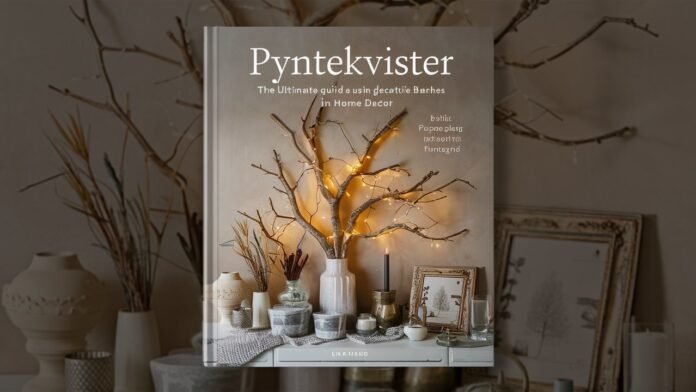In the world of home decor, simplicity often speaks volumes. One such element that has quietly gained popularity for its organic beauty and timeless appeal is the pyntekvister—decorative branches that add a touch of nature and elegance to any space. Whether you find them in nature, purchase them at a boutique, or craft your own, pyntekvister offer endless opportunities to express your personal style in both minimalistic and elaborate ways. From seasonal arrangements to permanent fixtures in modern interiors, these branches are a versatile and sustainable way to elevate your living environment. In this guide, we explore how to use pyntekvister creatively and effectively throughout your home.
What Are Pyntekvister and Why Are They So Popular?
Pyntekvister, or decorative branches, are natural or artificial twigs and stems often used for embellishing interior spaces. Typically sourced from willow, birch, eucalyptus, or cherry blossom trees, they can be left in their natural state or painted, glittered, and combined with flowers or lights. Their rising popularity is closely tied to the minimalistic, Scandinavian-inspired decor trends that emphasize natural materials and sustainable beauty. Unlike traditional floral arrangements, pyntekvister require little to no maintenance, making them ideal for busy households or those with allergies to pollen. Furthermore, their ability to fill vertical spaces makes them an excellent alternative to wall art or shelving.
Creative Ideas for Decorating With Pyntekvister Year-Round
One of the most appealing aspects of pyntekvister is their flexibility across seasons. In spring, you can combine them with pastel-colored faux flowers or painted eggs for a fresh Easter-themed arrangement. In summer, they pair beautifully with seashells or dried lavender, exuding a breezy, coastal vibe. Come autumn, opt for golden-toned branches mixed with pumpkins or dried leaves to bring warmth and richness indoors. During winter, pyntekvister can be adorned with fairy lights, ornaments, or snow spray to create a festive and cozy ambiance. Regardless of the season, these branches serve as an adaptable decor piece that can be reinvented time and again without requiring a full decor overhaul.
DIY Pyntekvister Arrangements: Crafting Beauty at Home
Creating your own pyntekvister arrangement is not only cost-effective but also a fulfilling artistic endeavor. Begin by selecting a vase or container that matches the style of your home—glass for modern elegance, ceramic for rustic charm, or metallic for an industrial edge. Choose your branches thoughtfully; mix natural wood with painted or treated stems to add contrast and interest. You can also weave in elements like dried flowers, ribbons, or beads for added texture. When arranging them, consider varying the heights and angles to mimic the asymmetry of nature. If you’re decorating for a special occasion like a wedding or holiday, tailor your arrangement’s colors and accessories accordingly. The beauty of pyntekvister lies in their ability to reflect your unique taste while embracing the organic imperfections of nature.
Pyntekvister Trends: What’s In Style Now?
In recent years, interior design trends have leaned heavily toward sustainable and nature-inspired elements. Pyntekvister fit perfectly into this aesthetic. Currently, dried eucalyptus and pampas grass are particularly popular, often seen in social media decor reels and design magazines. Monochrome branches—especially black, white, or gold-painted ones—are in vogue for minimalist or glam interiors. Another rising trend is the use of LED-lit branches, which combine ambient lighting with natural form. People are also beginning to hang pyntekvister horizontally from ceilings or walls, almost like floating sculptures. Whether used in a minimalist apartment or a boho-chic home, pyntekvister are proving to be an essential part of the modern decor toolkit.
Where to Buy Pyntekvister Online and What to Look For
There are numerous online stores that sell both natural and artificial pyntekvister. When shopping online, look for quality images, customer reviews, and clear size measurements to ensure the branches will fit your intended space. Sites like Etsy, Amazon, and Scandinavian interior boutiques often have wide selections that cater to various styles. Opt for responsibly sourced wood if you prefer natural branches, and be sure to check whether the product includes extras like lights or accompanying decor. If you’re on a budget or enjoy customization, you might consider collecting branches from your garden or local park (with permission) and decorating them yourself for a personal touch.
Conclusion
Pyntekvister are more than just sticks in a vase—they’re a timeless and elegant way to bring nature indoors. Whether you’re aiming for a cozy hygge-style nook, a modern minimalist corner, or a festive seasonal centerpiece, these decorative branches offer unmatched versatility and style. With just a little creativity, you can transform simple twigs into stunning design statements that reflect your personality and aesthetic values. As more people embrace eco-conscious and handcrafted decor, pyntekvister are sure to remain a favorite in homes around the world.
❓ FAQ: Pyntekvister (Decorative Branches)
What are pyntekvister made of?
Pyntekvister can be made of real tree branches such as birch, willow, or eucalyptus, or they can be artificial, made from materials like plastic, metal, or synthetic fibers.
Can I use pyntekvister outdoors?
Yes, but if they are not treated for outdoor use, natural branches may degrade over time. Artificial branches are generally more durable for outdoor conditions.
How do I clean decorative branches?
Dust them gently using a microfiber cloth or a feather duster. For artificial pyntekvister, you can also use a slightly damp cloth if needed.
How long do natural pyntekvister last?
If kept dry and out of direct sunlight, natural pyntekvister can last for months or even years. Dried branches are particularly long-lasting.
Where can I buy pyntekvister?
You can purchase them online from platforms like Etsy, Amazon, and home decor stores, or even collect them from nature for DIY projects.


